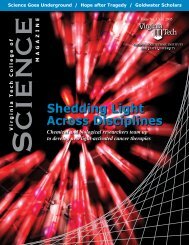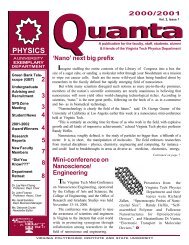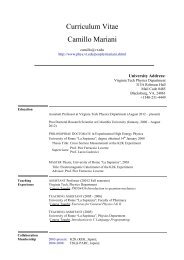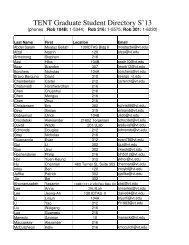Springer Lecture Notes in Physics 716
Springer Lecture Notes in Physics 716
Springer Lecture Notes in Physics 716
You also want an ePaper? Increase the reach of your titles
YUMPU automatically turns print PDFs into web optimized ePapers that Google loves.
314 U. C. Täuber<br />
is to f<strong>in</strong>d a curve parametrisation µ(l) =µl <strong>in</strong> the space spanned by the<br />
parameters ˜D, ˜τ, andũ such that<br />
l d ˜D(l)<br />
dl<br />
= ˜D(l) γ D (l) , l d˜τ(l)<br />
dl<br />
= ˜τ(l) γ τ (l) , l dũ(l)<br />
dl<br />
= β u (l) , (7.76)<br />
with <strong>in</strong>itial values D R , τ R ,andu R , respectively at l =1.Thefirst-order ord<strong>in</strong>ary<br />
differential equations (7.76), with γ D (l) =γ D (ũ(l)) etc. def<strong>in</strong>e runn<strong>in</strong>g<br />
coupl<strong>in</strong>gs that describe how the parameters of the theory change under scale<br />
transformations µ → µl. The formal solutions for ˜D(l) and˜τ(l) read<br />
˜D(l) =D R exp<br />
[ ∫ l<br />
1<br />
γ D (l ′ ) dl′<br />
l ′ ]<br />
, ˜τ(l) =τ R exp<br />
[ ∫ l<br />
1<br />
γ τ (l ′ ) dl′<br />
l ′ ]<br />
. (7.77)<br />
For the function ˆχ(l) =ˆχ R ( ˜D(l), ˜τ(l), ũ(l)), we then obta<strong>in</strong> another ord<strong>in</strong>ary<br />
differential equation, namely<br />
which is solved by<br />
l dˆχ(l)<br />
dl<br />
ˆχ(l) =ˆχ(1) l 2 exp<br />
=[2+γ S (l)] ˆχ(l) , (7.78)<br />
[ ∫ l<br />
1<br />
γ S (l ′ ) dl′<br />
l ′ ]<br />
. (7.79)<br />
Collect<strong>in</strong>g everyth<strong>in</strong>g, we f<strong>in</strong>ally arrive at<br />
[<br />
χ R (µ, D R ,τ R ,u R , q,ω)=(µl) −2 exp<br />
× ˆχ R<br />
(<br />
−<br />
∫ l<br />
1<br />
γ S (l ′ ) dl′<br />
l ′ ]<br />
˜τ(l), ũ(l), |q|<br />
µl , ω<br />
˜D(l)(µl) 2+a )<br />
. (7.80)<br />
The solution (7.80) of the RG equation (7.75), along with the flow equations<br />
(7.76), (7.77) for the runn<strong>in</strong>g coupl<strong>in</strong>gs tell us how the dynamic susceptibility<br />
depends on the (momentum) scale µlat which we consider the theory.<br />
Similar relations can be obta<strong>in</strong>ed for arbitrary vertex functions by solv<strong>in</strong>g the<br />
associated RG equations (7.65) [13]. The po<strong>in</strong>t here is that the right-hand side<br />
of Eq. (7.80) may be evaluated outside the IR-s<strong>in</strong>gular regime, by fix<strong>in</strong>g one<br />
of its arguments at a f<strong>in</strong>ite value, say |q|/µ l = 1. The function ˆχ R is regular,<br />
and can be calculated by means of perturbation theory. A scale-<strong>in</strong>variant<br />
regime is characterised by the renormalised nonl<strong>in</strong>ear coupl<strong>in</strong>g u R becom<strong>in</strong>g<br />
<strong>in</strong>dependent of the scale µl,orũ(l) → u ∗ = const. For an RG fixed po<strong>in</strong>t to<br />
be <strong>in</strong>frared-stable, we thus require<br />
β u (u ∗ )=0, β ′ u(u ∗ ) > 0 , (7.81)
















